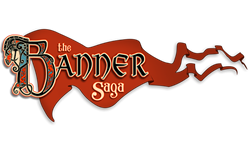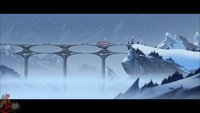|
|

|
PLATFORM
|
PS4
|
BATTLE SYSTEM
|

|
INTERACTION
|

|
ORIGINALITY
|

|
STORY
|

|
MUSIC & SOUND
|

|
VISUALS
|

|
CHALLENGE
|
Adjustable
|
COMPLETION TIME
|
Less than 20 Hours
|
|
OVERALL

|
+ Interesting story and presentation
+ Beautiful soundtrack
+ Unique blend of genres
- Text is hard to read
- Visibility issues in combat
- Hard to get attached to characters
|
Click here for scoring definitions
|
|
|
The Banner Saga is a very ambitious game. Its praises were widely sung when the game released on PC back in 2014, while console gamers had to wait until the beginning of 2016 to get a taste. I am a huge fan of Norse mythology and Vikings, so of course The Banner Saga was on my radar as I eagerly awaited its release on a console. It's definitely an inspiring game in a lot of ways, but it does have some pitfalls it doesn't entirely recover from.
One of The Banner Saga's accomplishments comes in the form of its branching narrative. Taking on the role of Viking clans, players navigate through a difficult march as the world has become plagued by the Dredge, the darkness that has manifested within the world. Players will change character points-of-view quite frequently, as each clan and its lead is attempting to figure out how it can protect its people without the Dredge destroying them. Many of the main story sequences are played out in beautiful hand-drawn animated sequences that are clearly inspired by Don Bluth films, and it fits the dark atmosphere of a world on the brink of survival. The Banner Saga plays out like a choose-your-own-adventure game, as challenging decisions are frequent, and knowing whom to trust is half the battle.
In fact, decision making is the majority of what players will be doing in The Banner Saga. A lot of the characters that the player will encounter will attempt to offer council, though it's ultimately up the player to figure out what is the best course of action. Every action has a consequence or reward, and it's important to keep up morale. The lower the morale the more frequently clansmen begin to argue and tougher calls must be made. Players have to gauge not only morale, but in true Oregon Trail fashion, must be conscious of supplies, and know when to rest and when to keep charging forth. These elements must be managed, and it can be quite the challenge. However, all of these elements build towards The Banner Saga's fantastic and dim atmosphere, and it plays with the player's emotions.
 A disaster waiting to happen.
A disaster waiting to happen.
|
|
One downside, however, in this approach to storytelling, is that it's difficult to become attached to characters. In many situations characters will die or leave the party, but it's often only learned through text within the narrative. When a character dies in most games, it's usually a pivotal moment in the story. When a character dies in The Banner Saga, it can feel like that person was just a disposable character. It should evoke more feeling than it actually does, because characterization really does matter, and the game has so many characters that it's hard to really get to know them for any length of time.
Combat is presented as a grind-based tactical RPG. Players will begin the battle by selecting and placing their units on the battlefield. It's apparent that this was once a PC game, because the PlayStation 4 controls are a touch awkward at first. Using the D-Pad allows the player to cycle through all the units on the field, while the thumbstick allows the player to move around the map and select actions. It's easy to get confused and use the D-Pad to think that it's for moving characters. It also doesn't help that The Banner Saga only offers a small degree of camera movement in the form of zooming in and out, which can prevent players from getting a useful view of the action in corners. Many of the enemies are quite large, so it's difficult to see around them in order to be able to strategically place a unit.
Despite these odd design choices to make the game work with the controller, combat is quite engaging. Each character has a race and class which determines his movement and special skills. Varl take up four squares of the battlefield and are quite large, while humans only take up one space. When player characters are lined up together, it strengthens their defenses. Placement is everything in this game because once a unit has moved, there's no way to take it back. This is why line of sight is so important. It's easy to think a unit is next to an enemy when it actually isn't. Once a character has line of sight on or is placed next to an enemy he can use a standard attack with the choice of damaging the enemy's shields or health. He can also use Willpower to strengthen the attack, adding more points of damage depending on the number of Willpower accumulated by the character. Each character also has a special move, and Willpower can be attributed to beef it up as well. There's definitely a lot of thought that goes into each of the player's action, as it's so easy to shoot one's self in the foot with any misstep.
The Banner Saga's approach to grid-based combat is quite unique in that health helps determine the amount of damage a fighter can produce. In a lot of ways it encourages players to leave nearly dead enemies alive because it deters the stronger ones from getting as many turns. Armor alleviates damage, while power is both the life and attack strength of a character. Positioning becomes even more key as players need to determine when it's more important to take out an enemies’ armor or his attack power. Weaker characters such as archers and menders can pack a powerful punch, while Varl can soak damage. This system is unusual, but it's clever in its approach and it adds to the depth of strategy presented in the game.
 The Dredge! The Dredge are coming! THE DREDGE!
The Dredge! The Dredge are coming! THE DREDGE!
|
|
While the visuals are absolutely stunning and definitely highlight the atmosphere of the game, there are a few issues. One is that the text in the game is quite small, and in instances where the player has stopped in a town, is next to impossible to see. Often it's hard to distinguish which building represents what task can be done, as the blueish-white text over the building is difficult to read over snow-white backgrounds. Still, the rest of the visuals really capture how isolated the world of Banner Saga is, and even with these minor drawbacks, it's still a sight to be seen.
And then there's the soundtrack, which by far is the game's crowning achievement. There's such a variety of instruments, and the music does a phenomenal job of immersing the player in the overall world. It evokes so much emotion and feeling without overpowering the game on a whole. There's sadness within the songs that just strikes a chord, and it digs deep into one's soul. It not only captures the turmoil and hardships, but it's so perfectly placed in the story sequences that it does an amazing job of making players feel like clansmen on a road to who knows where.
Finishing The Banner Saga left me emotionally wrought, tired, and sad. This is not one of those games where a happy outcome is possible; there's no world to be saved. There is only survival, and that alone often feels like it's simply not enough. What issues I did find in the game didn't destroy the overall experience for me because I know how emotionally invested I was throughout the journey. I was always worried that whatever decision I made, the consequence would be huge. The Banner Saga is for those who love having control of their narrative, weighing the risks and rewards, and seeing the outcomes. This is a game for those who want to gamble on the lives of their clansmen, though if you're one to get emotionally attached, this game may wreck you in the end.
Review Archives
|









